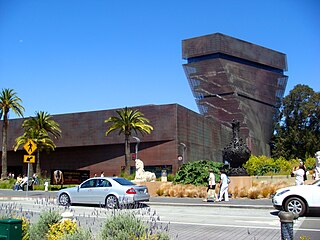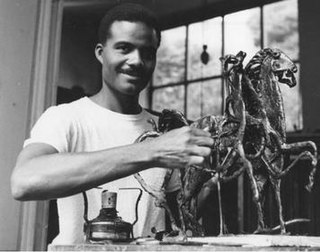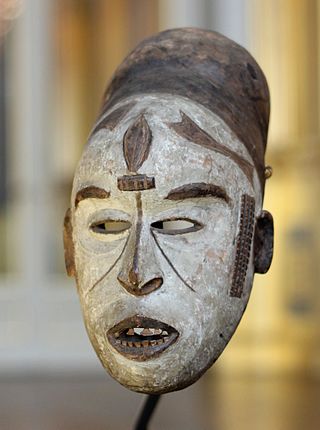
The Metropolitan Museum of Art, colloquially referred to as the Met, is an encyclopedic art museum in New York City. By floor area, it is the fourth-largest museum in the world and the largest art museum in the Americas. With 5.36 million visitors in 2023, it is the most-visited museum in the United States and the fifth-most visited art museum in the world.

Fairfield Porter was an American painter and art critic. He was the fourth of five children of James Porter, an architect, and Ruth Furness Porter, a poet from a literary family. He was the brother of photographer Eliot Porter and the brother-in-law of federal Reclamation Commissioner Michael W. Straus.

Sir John Wyndham Pope-Hennessy, was a British art historian. Pope-Hennessy was director of the Victoria and Albert Museum between 1967 and 1973, and director of the British Museum between 1974 and 1976. He was a scholar of Italian Renaissance art. Many of his writings, including the tripartite Introduction to Italian Sculpture, and his magnum opus, Donatello: Sculptor, are regarded as classics in the field.

The de Young Museum, formally the M. H. de Young Memorial Museum, is a fine arts museum located in San Francisco, California. Located in Golden Gate Park, it is a component of the Fine Arts Museums of San Francisco, along with the Legion of Honor. The de Young is named for early San Francisco newspaperman M. H. de Young.

The Asmat are an ethnic group of New Guinea, residing in the province of South Papua, Indonesia. The Asmat inhabit a region on the island's southwestern coast bordering the Arafura Sea, with lands totaling approximately 18,000 km2 (7,336 mi2) and consisting of mangrove, tidal swamp, freshwater swamp, and lowland rainforest.

The Musée du Quai Branly – Jacques Chirac, located in Paris, France, is a museum designed by French architect Jean Nouvel to feature the indigenous art and cultures of Africa, Asia, Oceania, and the Americas. The museum collection comprises more than a million objects, of which 3,500 are on display at any given time, in both permanent and temporary thematic exhibits. A selection of objects from the museum is also displayed in the Pavillon des Sessions of the Louvre.
Enrico Donati was an Italian-American Surrealist painter and sculptor.

Oceanic art or Oceanian art comprises the creative works made by the native people of the Pacific Islands and Australia, including areas as far apart as Hawaii and Easter Island. Specifically it comprises the works of the two groups of people who settled the area, though during two different periods. They would in time however, come to interact and together reach even more remote islands. The area is often broken down into four separate regions: Micronesia, Melanesia, Polynesia and Australia. Australia, along with interior Melanesia (Papua), are populated by descendants of the first waves of human migrations into the region by Australo-Melanesians. Micronesia, Island Melanesia, and Polynesia, on the other hand, are descendants of later Austronesian voyagers who intermixed with native Australo-Melanesians; mostly via the Neolithic Lapita culture. All of the regions in later times would be greatly affected by western influence and colonization. In more recent times, the people of Oceania have found a greater appreciation of their region's artistic heritage.

Papua New Guinean art refers to visual art created in Papua New Guinea or by Papua New Guinean artists. Papua New Guinea has been inhabited by humans for roughly 50,000 years; throughout that period, the hundreds of distinct ethnic groups of the island developed unique artistics traditions and styles. Statues and figurines, ritual masks, carvings, and weavings, all generally with spiritual and religious significance, comprise a majority of the art created historically in Papua New Guinea. In the late 20th century, a contemporary art movement emerged roughly the same time as the country gained its independence in the 1970s. This movement reflected both the nation's tribal traditions and customs as well as its progression towards modernization.

Herbert Ferber was an American Abstract Expressionist, sculptor and painter, and a "driving force of the New York School."
The Robert Goldwater Library in the department of the Arts of Africa, Oceania, and the Americas, of The Metropolitan Museum of Art is a noncirculating research library dedicated to the documentation of visual arts of sub-Saharan Africa, the Pacific Islands, and Native and Precolumbian America. The library is open to adult researchers, including college and graduate students.
Robert Goldwater was an American art historian, African arts scholar and the first director of the Museum of Primitive Art, New York, from 1957 to 1973. He was married to the French artist and sculptor Louise Bourgeois.

Tribal art is the visual arts and material culture of indigenous peoples. Also known as non-Western art or ethnographic art, or, controversially, primitive art, tribal arts have historically been collected by Western anthropologists, private collectors, and museums, particularly ethnographic and natural history museums. The term "primitive" is criticized as being Eurocentric and pejorative.

John W. Rhoden was an American sculptor from Birmingham, Alabama. Rhoden moved to New York in 1938, where he began studying with Richmond Barthé. Rhoden worked in wood and bronze, and created a number of commissioned works including Untitled (Family) at Harlem Hospital Center; Mitochondria at Bellevue Hospital Center in Manhattan; Curved Wal at the African American Museum in Philadelphia; Zodiacal Structure at the Sheraton Hotel in Philadelphia; and a sculpture of Frederick Douglass at Lincoln University.
James Thomas Hooper was a British collector of ethnographic artifacts of the Inuit, Native American, Oceanic and African peoples.
William Buller Fagg was a British curator and anthropologist. He was the Keeper of the Department of Ethnography at the British Museum (1969–1974), and pioneering historian of Yoruba and Nigerian art, with a particular focus on the art of Benin.

Some African objects had been collected by Europeans for centuries, and there had been industries producing some types, especially carvings in ivory, for European markets in some coastal regions. Between 1890 and 1918 the volume of objects greatly increased as Western colonial expansion in Africa led to the removal of many pieces of sub-Saharan African art that were subsequently brought to Europe and displayed. These objects entered the collections of natural history museums, art museums and private collections in Europe and the United States. About 90% of Africa's cultural heritage is believed to be located in Europe, according to French art historians.

The Benin ivory mask is a miniature sculptural portrait in ivory of Idia, the first Iyoba of the 16th century Benin Empire, taking the form of a traditional African mask. The masks were looted by the British from the palace of the Oba of Benin in the Benin Expedition of 1897.
Alisa LaGamma is the Ceil and Michael E. Pulitzer Curator of the Department of the Arts of Africa, Oceania, and the Americas at the Metropolitan Museum of Art.
Susan Mullin Vogel is a curator, professor, scholar, and filmmaker whose area of focus is African art. She was a curator at the Metropolitan Museum of Art, founded what is now The Africa Center in the early 1980s, served as Director of the Yale University Art Gallery, taught African art and architecture at Columbia University, and has made films.














